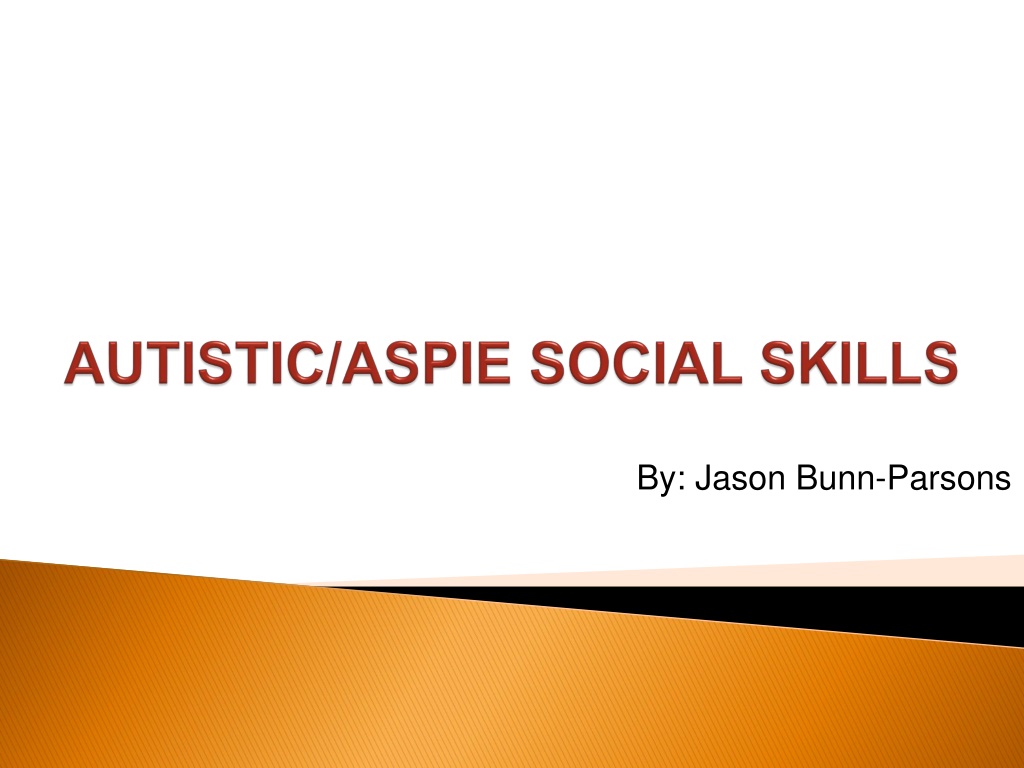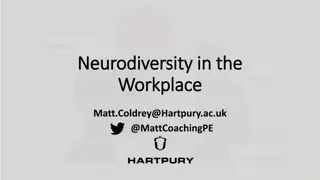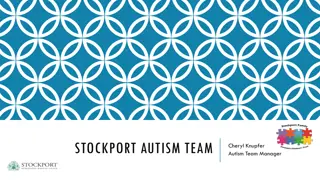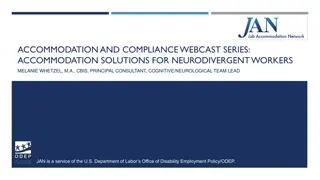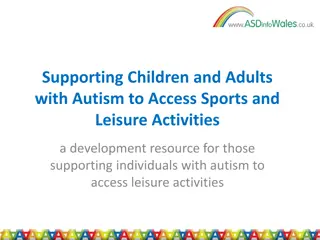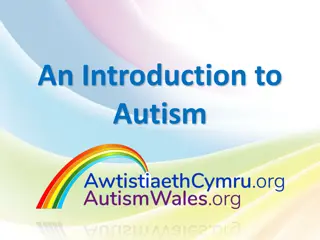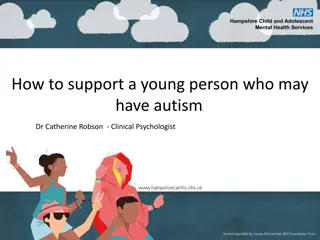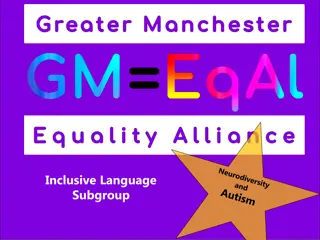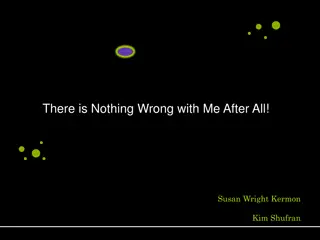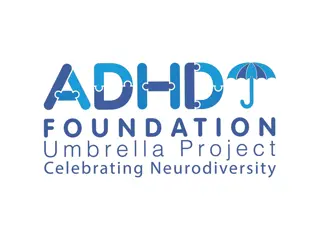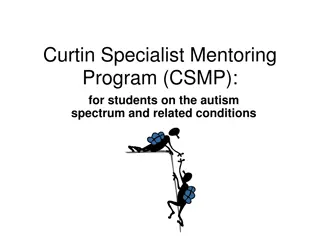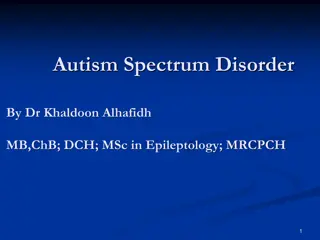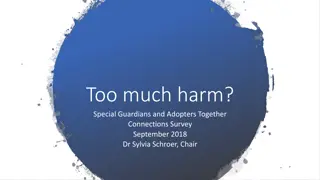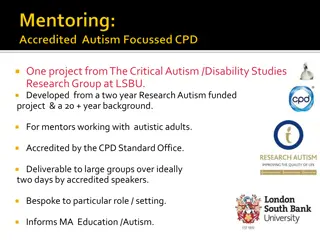Understanding Autism: Embracing Neurodiversity
The inherent needs and desires of Autistics/Aspies are no different from those of any other human beings, despite facing unique challenges in getting them met. This atypical neurological connectivity paradox leads to heightened activity in certain brain areas and decreased activity in others. Understanding the neurological roots and the paradoxical nature of Autism is key to fostering acceptance and inclusivity for Autistics. Embracing neurodiversity allows us to recognize the strengths and struggles faced by individuals on the Autism spectrum, challenging societal misconceptions and advocating for a more supportive environment.
Download Presentation

Please find below an Image/Link to download the presentation.
The content on the website is provided AS IS for your information and personal use only. It may not be sold, licensed, or shared on other websites without obtaining consent from the author. Download presentation by click this link. If you encounter any issues during the download, it is possible that the publisher has removed the file from their server.
E N D
Presentation Transcript
AUTISTICS/ASPIES ARE, 1STAND FOREMOST, HUMAN BEINGS 1. Autistics/Aspies have, as all human beings do, the same inherent needs, wants & desires, we just have some unique challenges in getting them met.
AUTISTICS/ASPIES ARE, 1STAND FOREMOST, HUMAN BEINGS 2. Just because the way society treats us makes us feel a certain way about ourselves, that does not make it true.
IN OTHER WORDS, WE ARE NOT BORN ON THE WRONG PLANET!!!
DEFINITION OF AUTISM Autism is an atypical neurological connectivity paradox resulting in heightened activity in some areas of the brain and decreased activity in others, compared to non-autistic individuals.
Atypical: 9 out of 10 individuals similar range of development, as well as means of completing certain routine tasks, problem solving, socializing, etc. The 10thindividual is Atypical.
Neurological Connectivity: The simple explanation of this is that Autism/Asperger s is, at its neurological roots, a neuro-connectivity issues. Our neuro-connections are atypical.
Paradox: The paradoxes of Autism can result in Autistics being extremely gifted in some areas, and extremely inept in others. The struggles Autistics deal with are often aggravated by people, who do not accept that Autism is a paradox, focusing solely on one aspect of Autism while refusing to acknowledge the paradoxical opposite.
BRAIN PLASTICITY The brain of every life form on Earth is constantly changing, enabling it to adapt in both positive and negative ways. This provides us with a scientific basis to believe that some areas which Autistics/ Aspies struggle with may self-correct and/or be modifiable.
BRAIN PLASTICITY This is not to say that we ever out grow Autism/Asperger s, but that just because we struggled with something 10-20 years ago, we should not assume that we will still struggle with it today.
BRAIN PLASTICITY Nevertheless, this process will eventually start working in reverse in all human beings once we reach the age in which all parts of our minds & bodies begin to deteriorate.
INPUT PROCESSING ISSUES The status quo approach to this topic is to refer to sensory processing issues. However, this overlooks the fact that the human brain is not only taxed by the sensory input that it has to process, but also by all neuro-activity that draws upon the brain s neuro-capacity.
INPUT PROCESSING ISSUES Although a specific issue may push us humans over the edge, we are often set up by an accumulation of previous issues. The best example of this in my personal life is that I can handle a certain level of noise while on public transportation as long as I am not mentally focused on an issue that I am looking for a solution.
INPUT PROCESSING ISSUES Furthermore, I do not have headaches when trying to find solutions in a quiet environment, no matter how challenging they may be. However, I have had headache while riding on public transportation, at time that it was not any nosier then usual, when my brain is in problem solving mode.
STRESS INFLAMES ALL HUMAN STRUGGLES, AND ALL HUMAN STRUGGLES INFLAMES STRESS
HOW OVERLOADS OF STRESS AND/OR EMOTIONS CAN AFFECT THE AUTISTIC BRAIN Stress can trigger what some Autistics would describe as Racing Brain. It is when we have multiple thoughts, and/or variations of how we might express what we want to say, coming to the forefront of our mind and making it difficult for us to make up our minds as to what to do and/or say.
HOW OVERLOADS OF STRESS AND/OR EMOTIONS CAN AFFECT THE AUTISTIC BRAIN The 2nd & 3rd of the following attributes can also result in Autistics responding to highly emotional situations in a way that causes those around them to believe they lack empathy. The last three ways Autistics are affected by stress mimic the signs of aging, fatigue, etc.
HOW OVERLOADS OF STRESS AND/OR EMOTIONS CAN AFFECT THE AUTISTIC BRAIN 1. Melt Downs 2. Shut Downs 3. Paralysis by Analysis 4. Decrease of what may already be sub par motor coordination
HOW OVERLOADS OF STRESS AND/OR EMOTIONS CAN AFFECT THE AUTISTIC BRAIN 5. Decrease of already sub par executive functioning 6. Extreme Reliance on Procedures, Rigid Protocols and Rehearsed Solutions
Our 5 senses, pertaining to our external sensory perceptions of the world around us.
Because of Autisms atypical neurological connectivity, the Autistic brain may process this input in an atypical manner resulting in: 1. Hyper sensory input: Resulting in extreme sensitivities and over responsiveness to certain sensory stimuli.
Because of Autisms atypical neurological connectivity, the Autistic brain may process this input in an atypical manner resulting in: 2. Hypo sensory input: Resulting in less responsiveness to certain sensory stimuli. 3. Confused sensory input: Resulting in an impaired ability to decipher sensory input.
WHATIS STIMMING? The Stimmer s concept of stimming: Involuntary repetitive motion RESULTING FROMEXCESSIVENEUROLOGICALACTIVITY. The Professional s concept of stimming: Involuntary repetitive motion THATSERVESNO FUNCTION. Note: There has been some movement in this area since Sue Golubock retired in 2012
WHATIS STIMMING? The stimmer is doing one or more of the following: 1. Thinking deeply about something 2. Burn off a sensory overload 3. Expressing their emotions, be it positive or negative. Examples: anxiety, excitement, pleasure, etc.
WHATIS STIMMING? 4. Communicating that there s something wrong with themselves and/or their environment. If this is the case, the cure for the stimming is to identify & eliminate the agitant(s).
WHEN YOU ELIMINATE A NON-COMMUNICATIVE PERSON S ABILITY TO STIM, YOU TAKE AWAY ONE OF THEIR FEW MEANS OF COMMUNICATION & SELF-EXPRESSION
THIS IS THE EQUIVALENT OF CUTTING OUT THEIR TONGUE!
Trying to find the right balance between the Stimmer s need to stim & the groups need to not be distracted has to be address on a case-by-case basis
ATYPICAL PERSONAL BUBBLE ISSUESOF AUTISTICS Autistics, who process sensory input in a variety of atypical manners, may be naturally inclined to respond to people in close proximity to them in a manner that is atypical.
ATYPICAL PERSONAL BUBBLE ISSUESOF AUTISTICS Non-Autistics who observe these responses may come to erroneous conclusions including, but not limited to, thinking that Autistics: Do not want affection Lack empathy Are manifesting phobias
ATYPICAL PERSONAL BUBBLE ISSUESOF AUTISTICS What Autistics may actually be experiencing are: 1. Adverse physiological reaction to touch, especially light tough because it is very stimulating to our nervous system. Countermeasures for this may include:
ATYPICAL PERSONAL BUBBLE ISSUESOF AUTISTICS a. Deep pressure touch, which relaxes the senses. This may be a more palatable and beneficial means of physical interaction. b. Allowing the Autistic to initiate the physical contact.
ATYPICAL PERSONAL BUBBLE ISSUESOF AUTISTICS 2. Trouble judging: a. The distance someone or something is to them. b. The direction that a sound is coming from.
ATYPICAL PERSONAL BUBBLE ISSUESOF AUTISTICS 3. Hyperactive sensory processing, which may require them to preserve a bigger bubble in order to
ATYPICAL PERSONAL BUBBLE ISSUESOF AUTISTICS a. have enough time to process all of the input that the brain is receiving before responding. b. focus on what they are thinking about instead of what is happening around them.
ATYPICAL PERSONAL BUBBLE ISSUESOF AUTISTICS 4. Autistics whose includes pacing need to preserve a big enough bubble so they can pace/stim. stimming repertory
MINIMIZINGTHE IMPACTOF SENSORY PROCESSING ISSUES Although not every Autistic/Aspie is going to struggle in this area to the same extent, consider the following solutions if you are. 1. Find environments that with little or no deliberate stimulation. 2. Smaller groups means there are few people around to create more stimuli.
MINIMIZINGTHE IMPACTOF SENSORY PROCESSING ISSUES Although not every Autistic/Aspie is going to struggle in this area to the same extent, consider the following solutions if you are. 3. Develop emergency protocols for situation in which you get ambushed by a flood of unexpected stimuli.
HYPER SENSITIVITYTO STRESSAND EMOTIONS It is crucial for Autistics/Aspies to realize that most, if not all, of our struggles may simply be more severe variations of the same issues that everyone else struggles with.
HYPER SENSITIVITYTO STRESSAND EMOTIONS This understanding can lead to us integrating some of their countermeasure into our overall self-management strategy that may need to be more extensive than others.
HYPER SENSITIVITYTO STRESSAND EMOTIONS This may also enable some Autistics to eventually be weaned off of some of their needs for special accommodations. Any strategy for dealing with any area of struggle must be at least two-pronged. If your stress management techniques are effective, then it will be easier to alleviate your other struggles.
HYPER SENSITIVITYTO STRESSAND EMOTIONS If your strategies for alleviating these other struggles are effective, then your stress will decline automatically. I cannot say that there is an effective countermeasure for every issue that Autistics struggle with. However ,
THEREAREEFFECTIVE COUNTERMEASURESFORMANYOF THESEISSUES! ALTHOUGHPOSITIVETHINKINGDOES NOTGUARANTEEPERSONAL SUCCESS, NEGATIVETHINKINGDOES GUARANTEEPERSONALFAILURE!
CONTROLLING STRESS & EMOTIONS The technics that enable neurotypicals to manage their stress & emotions will also work for Autistics/Aspies. The only difference is that the disciplined lifestyle that is required is optional for neurotypicals because they can often struggle through without them.
CONTROLLING STRESS & EMOTIONS Autistics/Aspies, because of their inherently higher baseline stress leave, have to discipline themselves into using these technics if they are going to overcome these situations. Their loved ones, teachers, caregivers, etc. can help them by developing these disciplines in themselves in order to mirror them to the Autistic/Aspie.
